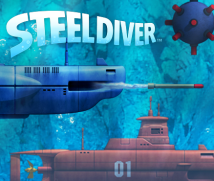4. F-Zero in Slow Motion
I don’t think anyone else would group F-Zero and Steel Diver together, so that’s very interesting. (laughs)

But I made it with that intention!
That’s the first I ever heard of it.
Me too.
(wearing an innocent expression) Ohhh?
(laughs)
Usually, you would tend to have a large opponent appear that you would defeat by upping the power of your torpedoes, but this game isn’t like that. You could describe it as the ultimate time trial. The movement is in slow motion, so you need skill.
You can use certain techniques to beat the course.
For example, in order to go around a certain corner, should you tilt the submarine, or let momentum carry it up, or inject air? The combinations of techniques are endless.
While some may find it plain, successfully navigating the courses without wildly veering around is an important element of the game.
So even if you think you did well, you never know if that’s the best score.
I want players to try the same courses over and over and thoroughly master them.
From the perspective of time trials, it is a lot like F-Zero!
Yeah. And like a racing game, you can save a ghost on each of the levels. However, since submarines move slowly and it takes time to reach the goal, it was hard making the save data. I guess that isn’t very flashy either. (laughs)
I can really understand how hard it must have been to record a ghost with a slow submarine on a long course.
To completely record the player’s behaviour would take more space than we had, so I talked with Giles, and we made repeated adjustments. In the end, the ghosts turned out to be incredibly natural. You can also play the game by turning on the staff ghost, learning the best course, and following that as best as you can.

You can learn how to best tackle the course by watching the ghost’s movement.
Right.
But that isn’t easy, right?
No. Each course has three staff ghosts: gold, silver and bronze. You can’t beat gold without putting forth some serious effort.
Gold is really tough.
The first one that comes out is bronze-class, so following it is relatively easy.
So it isn’t the kind of game you clear once and set aside. It’s like you’re trying to beat yourself. Even I, upon hearing what you just said, thought that I would like to go play it again! (laughs)
Yeah, I want people to play the same courses time and again. To that end, we added decals for powering up.
Decals are usually stickers you put on plastic models, right?
Yeah. We decided to use that word for the stickers you put on your submarine. We prepared about 30 types. You can collect them in bonus games. For example, if you put on a certain decal, you can generate a faster time, or if you put on a different decal, the damage taken from mines goes down. Each decal has a different property.
In other words, depending on the course, by changing your decal, you can get a better time or get through the course in a cool way.
Right. One decal will help you easily beat a battleship. I’d love it if players discover them all and get the most out of using them.
Also in the Missions mode, you had a hard time with collision detection when objects hit each other.

Oh, that’s right! Nice way to bring up collisions!
(laughs)
You move slowly, so when the submarine makes contact with a wall or something, there’s no hiding it. So if you even barely cut into a rock, it can be apparent.
Oh, I see. While some things might go unnoticed in faster-paced games, they’re immediately apparent at the slower speeds of a submarine.
Right. Not only are submarines slow, but they’re a complicated shape.
Lots of things, like the periscope, stick out from a submarine.
Yeah, that is difficult.
That’s why I even thought maybe we should give up on submarines and just use a container. (laughs)
Container? (laughs)
If a square object like a freight container were to go underwater, that would be much easier, but a submarine has projections like the periscope, which makes collisions difficult.
That’s right.
The reason Mario is a plump shape is because gaming devices at that time could only read collisions between square boxes, not because I wanted to make him cute. His design turned out like that because I adjusted for the capabilities of the gaming device of the day. For example, resolution was low, so I made his face big. But today’s game consoles can handle collisions with round or irregular shapes. Even so, it’s difficult with a complicated shape like that of a submarine.
So we assembled shapes like points and cigars.
You combined a number of different shapes for collisions.
Yes. If we hadn’t, bad things like getting stuck between rocks would happen.
I didn’t realise until hearing you say it today just how many difficulties are involved in slowly moving a complicated shape like a submarine.
That’s why I asked Giles to do it! (laughs) So he could figure it out.
He was a big help this time, as always.
No, no... (laughs) It felt just like when I was in EAD.

It felt like you were working together as one single group.
Yeah! (laughs)
